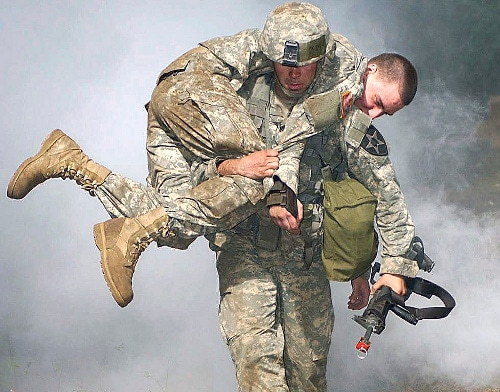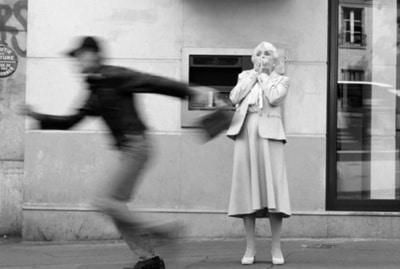
You spend hours crafting the perfect workout plan.
When you’re in the gym, you stick to your program religiously.
Every workout, you’re in #beastmode. You push yourself beyond your limits. The training hurts, but it’s a good kind of hurt. You’re making an Odinic sacrifice of self to self.
When it’s all done, you snap a pic for Instagram of your sweat angel on the floor to show the world you paid your dues that day. You caption it with “Pain is weakness leaving the body,” or if you’re feeling philosophical that day, you’ll quote Nietzsche about having a why and bearing any how.
And then you do it again the next day and every other day that week and year (including Christmas and Thanksgiving) because you’re a disciplined guy.
Yes, you take your training seriously. You’re a lion, a wolf, or whatever fierce totem spirit animal you prefer.
After a while, however, you start to notice something funny.
Despite the intensity of your program and despite thrashing yourself every workout, you’re not getting stronger.
But because you’re a man who takes his training seriously, you seriously start tweaking your program. You change up rep schemes and add supplement lifts. You might even change your entire program if things are really bad.
And then you get back at it with the same level of gusto, because, again, you take your training very seriously.
But to your dismay, you’re still not getting stronger.
How can this be?
Easy. Because you failed to understand that you don’t get stronger when you train.
You get stronger when you’re drinking a protein shake while watching an NCIS marathon on USA.
You Get Strong When You Recover: Understanding the Stress, Recovery, Adaptation Cycle
To understand why sitting on your keister and relaxing is what makes you stronger, and not #beastmoding in the gym, you need to understand the Stress-Adaptation-Recovery Cycle.
When the body is exposed to stress, it will begin a biological process to deal with that stress, recover from it, and then adapt and compensate so that it is better prepared to handle it if exposed to the same stressors again.
When it comes to weightlifting, your training is the stress. And according to the Stress-Adaptation-Recovery Cycle, you’re not getting stronger while you’re exposed to the stress; in fact, when you lift weights, the stress it produces causes your muscles to tear and break down.
Now don’t get me wrong. I’m not saying you shouldn’t train hard. The stress of training may not itself make you stronger, but it’s essential in kickstarting the process that does. It’s stress that starts the Stress-Adaptation-Recovery Cycle in the first place, and it has to be of sufficient intensity to put those wheels in motion. That requires working hard in the gym and embracing the grind.
But you only start getting stronger after the stress is over and absent — during the Adaptation and Recovery phases of the cycle. It’s during this period that your body starts repairing muscles and tissues, thus making them stronger than they were before, and ready to handle another round of stress.
Bottom line: You get stronger when you recover, not when you’re training.
If you get stronger only while you’re recovering, then why don’t more people take their recovery as seriously as their training?
Probably because they don’t know better. Fitness culture, in the United States particularly, puts a premium on thrashing yourself day in and day out. We like the satisfying pain of training our brains out. It’s a modern-day hair shirt. In contrast, recovering seems like boring, wimpy, unimportant stuff (not to mention it doesn’t show well on social media!).
Even though maxims about badass recovery will never make it onto a t-shirt, it’s just as important as your training. Here’s how to treat it as such.
Actually Give Your Body a Chance to Recover
Step #1 in taking your recovery as seriously as you do your training is to actually give your body time to recover. This means not training every single day of the week.
So for example, if you’re doing the novice Starting Strength program, you only lift 3 days a week.
With the advanced Starting Strength program that my Barbell Logic Online Coaching coach Matt Reynolds has me on, I lift 4 days a week.
In other lifting programs, you may be training 5-6 days a week, but you alternate between training your lower body some days, and upper body on the other days. So half your body gets to rest every other day.
The number of training vs. rest days you give yourself each week will depend on your specific training program, but the key is to give yourself at least some rest days.
A rest day doesn’t necessarily mean staying completely sedentary. You might do some exercise — but stuff that’s lighter and different than your main training routine. For example, on my rest days I’ll take a ruck or do MovNat exercises to keep myself limber. You can take a walk, or play some ultimate Frisbee, or roughhouse with your kids. It’s okay to throw in some straight up vegging as well, like watching NCIS with your dad, because dads love watching NCIS.
The central guideline is to not push yourself so hard on your rest days that you disrupt your body’s recovery process.
If you’re training hard, but feel tired, lack energy and motivation, and aren’t making progress in the gym, then you’re probably violating this guideline and need to dial things back more.
The 2 Most Important Things for Recovery: Food and Sleep
Besides taking it easy sometimes, there are two things you should make a top priority: food and sleep.
Food. To build itself back up and adapt to the stress of training, your body requires plenty of fuel. So you need to eat good food and lots of it.
Whenever I’ve hit a plateau in my training, the first thing Matt asks me is, “Are you hitting your macro goals?” (Macro goals are the proportions of your daily calorie intake that come from carbs, fat, and protein, respectively.) If I’m not, he scolds me and tells me to do a better job. When I start complying, the plateau is magically broken. If I am hitting my macros, but still stalling in my progress, he’ll bump up my calories a bit because my body simply needs more food for recovery. Nine times out of ten that does the trick.
I’d venture to guess that the reason most men stall in their training is that they’re not eating enough food. How come? Because they’re trying to get shredded and lean. But as we’ve written before, you cannot get big and strong while getting shredded and lean at the same time. If you’re looking to get stronger, you gotta eat. Period.
I recommend following an If It Fits Your Macros (IIFYM) diet because it’s easy to implement and stick with. Check out this article for general guidelines on how much protein, carbs, and fat you should aim for each day. If you’re specifically looking to gain weight, then follow this guide. Once you’ve got your macros set, download MyFitnessPal and track everything you eat.
Be especially meticulous about getting enough protein each day: at least one gram per pound of bodyweight.
Train like a champion. Eat like a champion.
Sleep. While researchers are still puzzled about why we even sleep in the first place, we do know that it plays a vital role in our recovery from exercise.
When we enter the deep sleep state, our pituitary gland releases a pulse of human growth hormone to help with tissue repair and growth. When we enter REM sleep, testosterone levels increase, which also aids in tissue repair and growth. Basically, when we sleep, we bathe our bodies in perfectly legal and perfectly natural performance-enhancing “drugs.”
But if you’re not getting enough quality sleep, you’re missing out on that, your recovery is going to suffer, and, consequently, so is your training.
If I’m good on my diet, but my training is still suffering, it usually means I’m not getting enough shuteye. As soon as I make sleep a priority, I break through plateaus.
To improve your sleep, I recommend reading this guide. But really, there’s not much to it. Aim for 7-9 hours. Avoid caffeine late in the day. Avoid screens right before bed. Sleep in a dark, cool room.
The real challenge with sleep is that life just sometimes gets in the way of it. You and your wife just welcomed home a wonderful, colicky bundle of joy. Your kid gets sick in the middle of the night, and you’re making a trip to Walgreens at 2 AM. There’s not much you can do about these unexpected sleep disruptors, except trying to practice really good sleep hygiene on all the nights that go “right.”
But sometimes we stay up late for no good reason — we get pulled into watching a show or surfing the internet longer than we expected. Or we procrastinate a project until completing it will require an all-nighter. In these cases, it’s just a matter of setting a higher priority for your sleep, and respecting its vital role in your overall health.
Make your shuteye sacrosanct and your brain, as well as your body, will thank you.
Does Anything Else Work for Recovery?
While food and sleep are the most proven, effective methods for improving exercise recovery, there are increasingly more options and methods being offered these days. While most Americans still fetishize training without adequate recovery, a burgeoning fitness industry has emerged to cater to folks who are starting to take their rest as seriously as their training.
You can find spas dedicated to athletes that promise services that will “speed up” recovery. Deep tissue massages, dry saunas, and cryospas are just a few of the services these places offer.
But do they actually do anything for your recovery?
Starting Strength coaches and medical doctors Austin Baraki and Jordan Feigenbaum have looked at the research on this and found that stuff like massages and cryospas have little or no benefit when it comes to recovery from training.
They concede this stuff feels good (who doesn’t like a massage?) and that that good feeling likely offers some psychological benefit in helping reduce cortisol in your system, which in turn may help with recovery. Or it could just be placebo. But should you spend a lot of time and money on this stuff? No.
You’ll get more bang for your buck from eating healthy food and getting enough sleep, so focus on that. Once you’re taking care of those two things, if you want to get a massage or sit in the cryospa now and then because you like the way it feels, go for it.
A few other “icing on the cake of recovery” things you might consider if they feel good to you:
- Cold showers or ice baths
- Meditation
- Hot tub
- Epsom salt baths
- Float tank
- Foam rolling
- Cupping
- NormaTec
Experiment with what seems to work for you, and fits your budget and schedule.
Take Your Recovery as Seriously As Your Training
You don’t get stronger when you train. You get stronger when you recover. So take the time you spend in bed and at the table just as seriously as the time you spend in the gym!
Listen to our podcast on what really works for exercise/workout recovery:
Related Resources







